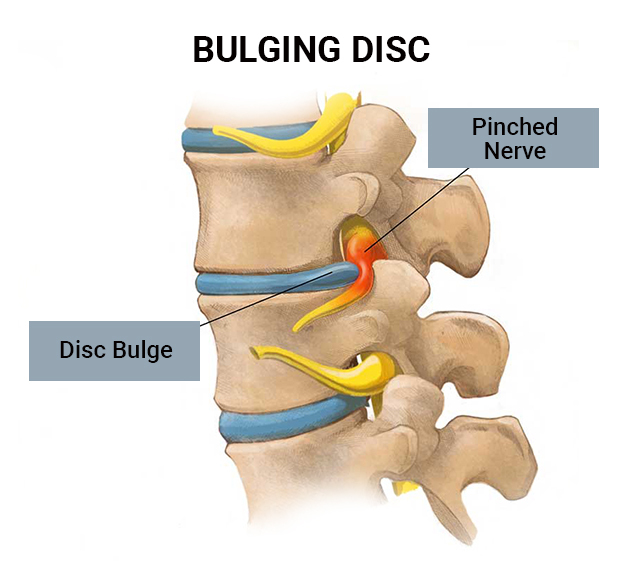What Is a Bulging Disc?
Your spine is made up of vertebrae with spinal discs in between to act as a shock absorbersand protect the spinal tissue and bone.They also make it easier to move around. Discs feature a hard outer shell and a liquid-like interior. Movement or slippage of the disc from its natural position causes an outward expansion of the fluid substance throughout the disc’s weakest spot. In many situations, the disc expands into the gaps between the vertebrae. This occurs over a long period of time. The longer an illness is left untreated, the worse the symptoms will grow. Bulging discs can also refer to a disc that protrudes.
Symptoms
A patient may have little to no pain if a bulging disc has not yet progressed to the degree of herniation. A bulging disc may not cause any discomfort since it has not reached a particular severity level, making it difficult to spot bulging disc symptoms before the disease worsens.
Bulging discs most typically cause pressure points on adjacent nerves, resulting in a range of symptoms. Depending on the degree, symptoms of a bulging disc might range from mild tingling and numbness to moderate or severe pain. When a bulging disc reaches this stage, it is usually on the verge of herniation.
The symptoms are as follows:
Tingling or discomfort in the fingers, hands, arms, neck, or shoulders. This could be due to a bulging disc in the cervical region.
Foot, thigh, lower spine, and buttock pain. This is the most prevalent symptom and may suggest a lumbar problem.
Difficulty walking or a sense of impediment when lifting or grasping objects.
These symptoms necessitate rapid medical attention from an orthopaedic surgeon since they may indicate a potentially fatal disease.
When the sciatic nerve is damaged, sensations run down one leg or the other. A bulging disc can compress the nerves that control the bladder, causing incontinence. In this instance, seek emergency medical attention right away.
A mid-spine bulging disc can cause upper back pain that radiates to the stomach or chest. Muscle spasms can arise as a result of any bulging disc. While some individuals may go years without experiencing bothersome symptoms, others may suffer from severe or life-threatening complications
Causes
You, the client, maybe the most knowledgeable about the reason for a bulging disc. Your doctor will ask you a number of questions about your lifestyle and the types of physical activity you’ve done in the past.
The most common cause of the illness is the natural ageing process, disc degeneration, and other risk factors. Discs may get increasingly brittle over time.
Other Causes for a Bulging Disc include:
People who have a sedentary lifestyle or who smoke are more likely to develop bulging discs.
Continuous strain on the disc caused by injury or hard lifting can wear it down over time.
Weakened back muscles might hasten the process, resulting in an abrupt herniation of the weakened disc.
Some kind of trauma. Although bulging discs develop over time, herniated discs can develop fast as a result of trauma.
Bad posture, including inappropriate body orientation, while sleeping, sitting, standing, or exercising, is one of the risk factors that might lead to the development of a bulging disc.
Obesity
High-contact sports and activities pose additional risks.
Runners who do not wear shoes with orthopaedic support may develop bulging discs.
Activities that put stress and pressure on the spine might cause disc degeneration.
Diagnosis
The Orthopaedic Hospital will conduct a thorough medical examination involving an X-ray. In certain circumstances, a CT or MRI scan is required to accurately diagnose bulging disc disorders. These testing formats reveal disc shape and condition changes.
Bulging Disc Therapy
Before deciding on bulging disc therapy or herniated disc surgery, there are a few things you should strive to avoid before deciding on any treatment, minimally invasive or not. Here are some non-surgical alternatives:
To lessen any bulging disc symptoms or pain caused by the damaged disc, a patient should first adjust their body positioning and behaviours (sleeping, sitting, and postural postures).
Addressing the underlying causes of the illness may assist to limit its progression.
Obese patients can benefit from a good weight loss strategy and exercise.
In some circumstances, a doctor may advise physical therapy to strengthen back muscles and regain lost mobility.
Many non-surgical therapies for bulging discs are effective before herniation. Pain management options vary according to severity. Anti-inflammatory drugs, both over-the-counter and prescription, can alleviate mild to moderate discomfort.
To alleviate pain symptoms, heating pads, ice packs, massage therapy, and exercise are all recommended. Some doctors may suggest taping or bracing to support the damaged area for a period of time. A surgeon can do surgery in emergency situations where the disc is creating life-threatening complications, but this is uncommon.
Last Thoughts
A bulging disc is a medical disease that develops gradually over time. Although it is more common in older persons, it can occur in younger people as well. There are few if any, symptoms, and early detection can only be achieved through medical testing and scans that reveal changes in disc form and location.
Before extensive disc bulging and herniation, some people may experience symptoms ranging from tingling to varying degrees of discomfort. The early discovery means that simpler therapies may be available to prevent the illness from deteriorating. If you have any questions, please contact us to talk with one of our experts.
